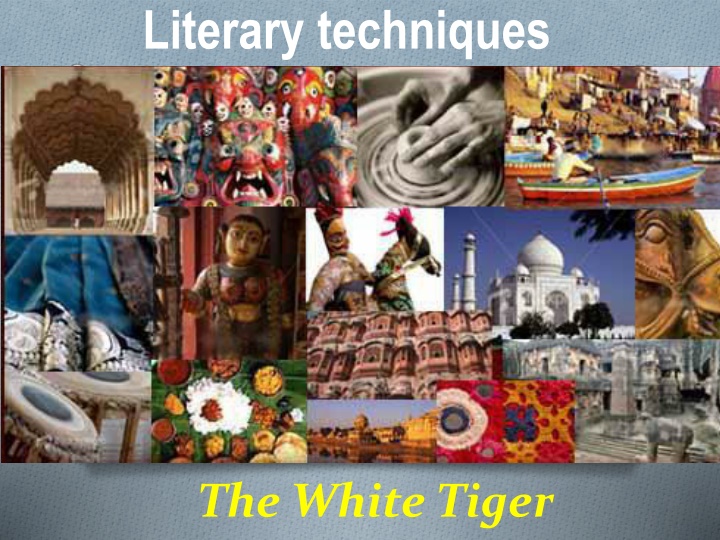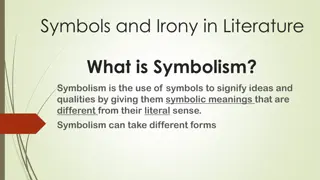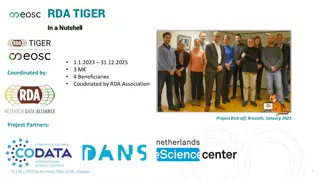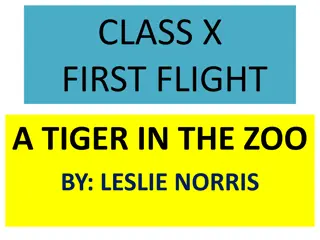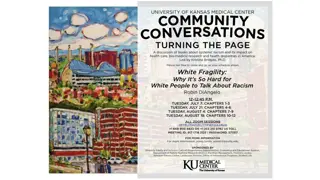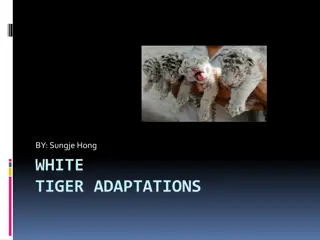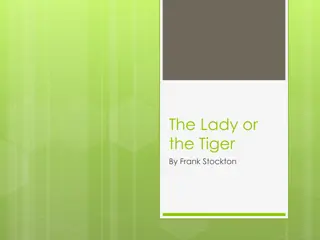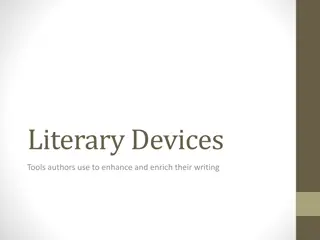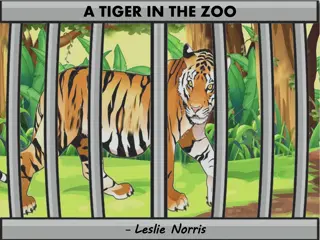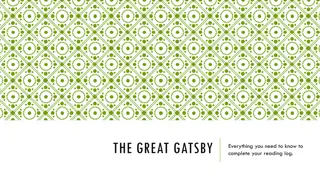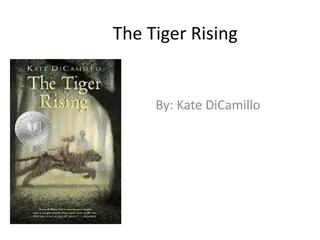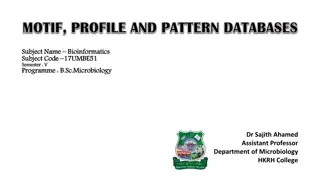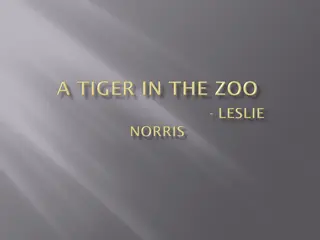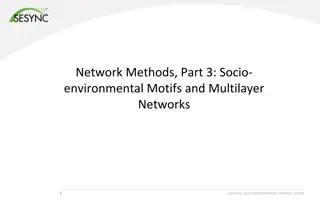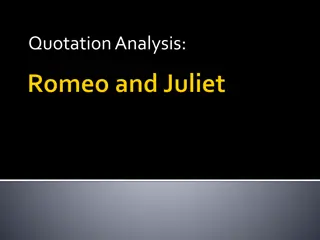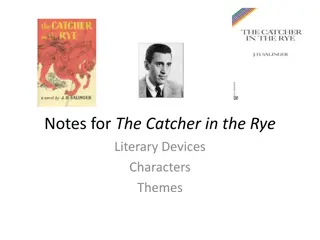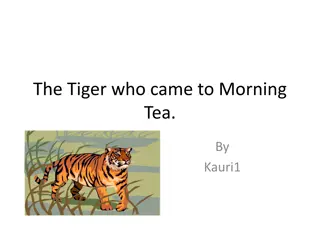Literary Techniques in "The White Tiger": Symbolism and Motifs Explored
"The White Tiger" by Aravind Adiga utilizes powerful literary techniques such as symbolism and motifs to convey deeper meanings. Through the symbolism of animals in nature, including the white tiger and the lizard, and recurring motifs like the inner struggles of the protagonist Balram, the novel paints a vivid picture of India's complex societal dynamics and individual transformation.
Download Presentation

Please find below an Image/Link to download the presentation.
The content on the website is provided AS IS for your information and personal use only. It may not be sold, licensed, or shared on other websites without obtaining consent from the author.If you encounter any issues during the download, it is possible that the publisher has removed the file from their server.
You are allowed to download the files provided on this website for personal or commercial use, subject to the condition that they are used lawfully. All files are the property of their respective owners.
The content on the website is provided AS IS for your information and personal use only. It may not be sold, licensed, or shared on other websites without obtaining consent from the author.
E N D
Presentation Transcript
Literary techniques The White Tiger
The White Tiger Symbolism
Motif Symbol O A recurring recurring element in a work. O A symbol symbol is an object (not necessarily tangible) that represents, stands for, or suggests an idea, visual image, belief, action, or material entity
Symbol an object (not necessarily tangible) that represents, stands for, or suggests an idea, visual image, belief, action, or material entity
Animals in Nature O Adiga uses a variety of animals, both domestic and wild, to illustrate his points about India s politics and culture. India is portrayed as a jungle, with different levels of society. O Some are on the hunt for prey and other simply avoid being consumed. Eat or be eaten up is the only way to live in India.
The White Tiger O The tiger is a fierce and majestic creature, but the white tiger is an animal of rare colouring. It is exceptional, as is Balram. O This image is self- explanatory and represents Balram as he outwardly appears to the reader and to his intended audience, Wen Jiabao. The white tiger symbolizes the outer Balram.
The Lizard O In india, considered to be a woose if scared of Lizards O Representative of the inner Balram O When threatened, the lizard can detach its tail in order to escape confinement. This is what Balram does on a couple of levels:
The Lizard O First, he divides himself morally and vacillates between feeling remorse and having no remorse for his deeds. He makes the decision to rob and murder Ashok because Ashok was willing to sacrifice Balram after Ashok s wife runs over a child in the street. O Second, after Ashok s death, Balram detaches himself, finally and completely, from his family and escapes from Delhi to the safety of Bangalore.
The Lizard O Early in the story, Balram s father kills the lizard at Balram s school against Balram s entreaties to let the lizard go. It is his father s single act of courage: My whole life, I have been treated like a donkey. All I want is that one son of mine at least one should live like a man. (p.26) (p.26) O The sad irony is that Balram, who couldn t bear to see the lizard be smashed, was able to later smash Ashok s skull with little difficulty.
The Rooster and Rooster Coop O roosters rarely take the opportunity to escape, even when the door is open, because they really have everything they need at hand hens and food. There are no further temptations for them beyond the cage. As long as they serve their purpose, they get to eat. O When they are no longer useful, they are eaten. This is Balram s theory of social class. (p.54) (p.54)
The Rooster and Rooster Coop O When Balram becomes a driver, he has everything he needs, money and food. With a full belly, Balram should be satisfied staying at this level. O When Balram becomes a driver, he has everything he needs, money and food. With a full belly, Balram should be satisfied staying at this level. O The trustworthiness of servants is the basis of the entire Indian economy ... Here in India we have no dictatorship. No secret police ... That s because we have the coop. (p.149) (p.149)
The Rooster and Rooster Coop O This is the old social truth of India. People were jammed and confined inside narrow social boundaries and had no room to move about and no hope for change. The roosters waited patiently to be cut into small edible pieces.
The Rooster and Rooster Coop O Go to Old Delhi, behind the Jama Masjid, and look at the way they keep chickens in the market. Hundreds of pale hens and brightly coloured roosters, stuffed tightly into wire-mesh cages, packed as tightly as worms in a belly, pecking each other and shitting on each other, jostling just for breathing space; the whole cage giving off a horrible stench the stench of terrified, feathered flesh. On the wooden deck above the coop sits a grinning young butcher, showing off the flesh and organs of a recently chopped-up chicken, still oleaginous with a coating of dark blood. The roosters in the coop smell the blood from above. They see the organs of their brothers lying around them. They know they re next. Yet they do not rebel. They do not try to get out of the coop. The very same thing is done with human beings in this country. (p.148) (p.148)
The Rooster and Rooster Coop O Balram represents the scores of people who are up- rooted and transported to city centres to work in call-centres, in IT and in industry. Once they escape the rooster coop, they never want to go back. But, to stay there, they sacrifice many things and people along the way. O The rooster represents a wake up call for India and China and the rest of the world. Adiga has opened the cage door to allow inspection and introspection.
The Water Buffalo O A water buffalo was kept by every family in the Darkness. They fed it, took care of it, and used its milk as nourishment and to sell at markets for extra cash. In the Darkness, the lives of many families (including Balram s) revolved around keeping the water buffalo fed, clean and healthy, sometimes at the expense of the families own well-being, simply because all their hopes were concentrated in her fatness. (p.17 (p.17)
The Water Buffalo O The water buffalo also represents an endless cycle of dependency and interdependency that no one seems able to break. The only way to do so is to compromise your family, just as Balram eventually does.
The Water Buffalo O In this way, the water buffalo embodies the rules of the rooster coop. Those who ignore the water buffalo, or run away from the Darkness, do so by sacrificing their relatives. The Darkness may be a poor and painful place, but it is a familiar way of life and it includes strong allegiance to the family. Neglecting the water buffalo is tantamount to butchering the family.
The Number Four O The number four is symbolically significant because it not only represents the four seasons and the four elements of life (earth, water, air, fire), but it also provides us with our point of reference, the four points of the global compass: North, South, East, West. O The idea is that if we know where we are, we can know where we are going.
The Number Four Adiga uses the number four to link the known to the unknown, truth to illusion, and past to future: O The Buffalo, the Stork, the Wild Boar and the Raven O Balram has four names: Munna, Balram, the white tiger and his last, self-given name, Ashok Sharma.
The Number Four Despite Adiga s use of the number four, Balram is constantly naming three of everything, leaving the fourth unidentified: O Balram refers to his favourite four poets: Rumi, Iqbal, Mirza Ghalib, but can t remember the fourth. O Revolutionaries who fought to free their country s slaves: Alexander the Great, Lincoln, and Chairman Mao. Balram considers the possible mention of Hitler as the fourth, but he is not really sure. O three traditional myths that are no longer solid supports of the country: God, Gandhi, and family. He says that the fourth myth, the one that might rescue today s India, is still unknown.
The Number Four This is Adiga s point: the future is, as yet, unrevealed. Balram acts as all three fates: O He is the witness observing the current situation. O He is the prophet forewarning the possibility of doom. O Balram is also the agent who may himself lead the country into disaster.
The Red Bag O Red bag, they should have said. Without the colour, the information is all but useless, isn t it? No wonder I was never spotted. (p.27) (p.27)
O It makes me happy to see a chandelier. Why not, I m a free man, let me buy all the chandeliers I want. For one thing, they keep the lizards away from this room. It s the truth, sir. Lizards don t like the light, so as soon as they see a chandelier, they stay away. (p.99) (p.99) The Chandelier
The Chandelier O It makes me happy to see a chandelier. Why not, I m a free man, let me buy all the chandeliers I want. For one thing, they keep the lizards away from this room. It s the truth, sir. Lizards don t like the light, so as soon as they see a chandelier, they stay away. (p.99) (p.99) O to Balram they are a significant symbol of status status and freedom.
The Black Fort OUnattainable, a dream OWithin sight OClimbable pp 21, 40, 86 .
The River Ganges OHoly, many believe that life is not complete until one has bathed in the river s waters OFilth, disease page 12 OThe fecundity it brings to its banks brings wealth, not to those who live there, but to those who eat up the profits from it and live on the coast in the Light.
Irony O Contradictions between literal and apparent meanings O What he says is different to what you understand to be truly going on O Helps characterise Balram as the white tiger figure someone who builds a deep resentment and refusal to continue along the path of his ancestors, and who has the guts or belly to make a move out of it
